Logging Identification Methods for Oil-Bearing Formations in the Chang 6 Tight Sandstone Reservoir in the Qingcheng Area, Ordos Basin
Abstract
1. Introduction
2. Geologic Setting
3. Data and Methods
3.1. Data and Sample Description
3.2. Hyperbolic Normalized Superposition Reconstruction Method
- (1)
- Normalize the AC and CNL curves of the selected wells using the normalization equation to obtain the normalized logging curves AC* and CNL*:where X*, Xmin, and Xmax are the normalized, minimum, and maximum lithological logging characteristic values, respectively.
- (2)
- The thick silty mudstone in the Chang 6 reservoir of the study area was selected as the marker layer. Using this marker layer as a reference, the normalized AC* and CNL* curves were shifted by adding or subtracting to achieve overlap between the AC* and CNL* curves.
- (3)
- The average values of AC and CNL data corresponding to the same lithology at different depths were determined at intervals of 0.5 m. The difference between the gamma values in the different lithologies and normalized curves, namely, Δφ (obtained by subtracting CNL* values from AC* values), was used to construct a cross-plot used to identify the tight fine sandstone.
4. Results
4.1. Characteristics of the Tight Sandstone Reservoir
4.1.1. Physical Characteristics
4.1.2. Lithological Characteristics
4.1.3. Electrical Characteristics
4.1.4. Oil-Bearing Characteristics
4.2. Reservoir Lithology Identification
4.2.1. Type of Lithology
4.2.2. Lithology Identification Criteria
4.3. Fluid Identification
4.3.1. Fluid Types and Characteristics
4.3.2. Fluid Identification Criteria
4.3.3. Multi-Curve Superposition Method for the Determination of Reservoir Thickness
5. Discussion
5.1. Verification of Lithology Identification by Hyperbolic Normalized Superposition Reconstruction Method
5.2. Validation of the Identification of the Fluid Types
6. Conclusions
- (1)
- The hyperbolic normalized superposition reconstruction method can quickly and effectively identify the lithology of tight fine sandstone, silty mudstone, mudstone, and carbonaceous mudstone. The natural gamma value of tight fine sandstone was less than 96 API, and the normalized curve difference (Δφ) was greater than 0.05; that of silty mudstone was between 96 and 123 API, and the normalized difference (Δφ) was between −0.05 and 0.05; that of mudstone was between 123 and 141 API, and the normalized difference (Δφ) was between −0.05 and 0.05; that of carbonaceous mudstone was between 141 and 185 API, and the normalized difference (Δφ) was less than −0.05.
- (2)
- The induced conductivity–porosity–density intersection diagram can help identify the oil and water layers more effectively. For the tight oil layers, the induced conductivity was between 18 and 28.1 mS/m, the density was between 2.42 and 2.56 g/cm3, the porosity was more than 9.5%, and the oil saturation was more than 65%. For the tight water layers, the induced conductivity was greater than 48.6 mS/m, the density was between 2.46 and 2.56 g/cm3, and the porosity was greater than 9.5%. For the tight dry layers, the induced conductivity was more than 19.2–41.65 mS/m, the density was between 2.54 and 2.68 g/cm3, and the porosity was less than 9.5%. For the oil–water layers, the induced conductivity was between 34.8 and 49.6 mS/m, the density was between 2.46 and 2.58 g/cm3, and the porosity was between 8.8 and 10.1%.
- (3)
- The thickness of the oil layer in tight fine sandstone can be effectively determined using the method of superposition of the difference and induced conductivity curves.
Supplementary Materials
Author Contributions
Funding
Data Availability Statement
Conflicts of Interest
References
- Dou, L.; Wen, Z.; Wang, J.; Wang, Z.; He, Z.; Liu, X.; Zhang, N. Analysis of the world oil and gas exploration situation in 2021. J. Pet. Explor. Dev. Online 2022, 49, 1033–1044. [Google Scholar] [CrossRef]
- Zou, C.; Yang, Z.; Dong, D.; Zhao, Q.; Chen, Z.; Feng, Y.; Li, J.; Wang, X. Formation, Distribution and Prospect of Unconventional Hydrocarbons in Source Rock Strata in China. Earth Sci. 2022, 47, 1517–1533. [Google Scholar]
- Zhou, N.; Lu, S.; Wang, M.; Huang, W.; Xiao, D.; Jiao, C.; Wang, J.; Tiao, W.; Zhou, L.; Chen, F.; et al. Limits and grading evaluation criteria of tight oil reservoirs in typical continental basins of China. Pet. Explor. Dev. 2021, 48, 1089–1100. [Google Scholar] [CrossRef]
- Fu, S.; Jin, Z.; Fu, J.; Li, S.; Yang, W. Transformation of understanding from tight oil to shale oil in the Member 7 of Yanchang Formation in Ordos Basin and its significance of exploration and development. Acta Pet. Sin. 2021, 42, 561. [Google Scholar]
- Li, G.; Lei, Z.; Dong, W.; Wang, H.; Zheng, X.; Tan, J. Progress, challenges and prospects of unconventional oil and gas development of petrochina. China Pet. Explor. 2022, 27, 1–11. [Google Scholar]
- Zou, C.; Qiu, Z.; Zhang, J.; Li, Z.; Wei, H.; Liu, B.; Zhao, J.; Yang, T.; Zhu, S.; Tao, H.; et al. Unconventional petroleum sedimentology: A key to understanding unconventional hydrocarbon accumulation. Engineering 2022, 18, 62–78. [Google Scholar] [CrossRef]
- Yang, Z.; Zou, C. On the orderly “symbiotic enrichment” of conventional–unconventional oil and gas: On the theoretical techniques of conventional–unconventional oil and gas geology. J. Acta Geol. Sin. 2022, 96, 1635–1653. [Google Scholar]
- Yang, Z.; Zou, C.; Wu, S.; Pan, S.; Wang, L.; Pang, Z.; Lin, S.; Li, J. From source control theory to source–reservoir symbiosis system: On the theoretical understanding and practice of source rock strata oil and gas geology in China. Acta Geol. Sin. 2021, 95, 618–631. [Google Scholar]
- Jia, C.; Zheng, M.; Zhang, Y. Unconventional hydrocarbon resources in China and the prospect of exploration and development. J. Pet. Explor. Dev. Online 2012, 39, 139–146. [Google Scholar] [CrossRef]
- Qiu, Z.; Zou, C.; Mills, B.; Xiong, Y.; Tao, H.; Lu, B.; Liu, H.; Xiao, W.; Poulton, S. A nutrient control on expanded anoxia and global cooling during the Late Ordovician mass extinction. J. Commun. Earth Environ. 2022, 3, 82. [Google Scholar] [CrossRef]
- Zou, C.; Guo, Q.; Yang, Z.; Wu, S.; Chen, N.; Lin, S.; Pan, S. Resource potential and core area prediction of lacustrine tight oil: The Triassic Yanchang Formation in Ordos Basin, China. AAPG Bull. 2019, 103, 1493–1523. [Google Scholar] [CrossRef]
- Zou, C.; Tao, S.; Yuan, X.; Zhu, R.; Dong, D.; Li, W.; Wang, L.; Gao, X.; Gong, Y.; Jia, J.; et al. Global importance of“continuous”petroleum reservoirs: Accumulation, distribution and evaluation. J. Pet. Explor. Dev. 2009, 36, 669–682. [Google Scholar]
- Zhao, J. Conception, classification and resource potential of unconventional hydrocarbons. J. Nat. Gas Geosci. 2012, 23, 393–406. [Google Scholar]
- Hu, S.; Tao, S.; Yan, W.; Men, G.; Tang, Z.; Xue, J.; Jia, X.; Chen, X.; Jiang, T.; Huang, D.; et al. Advances on enrichment law and key technologies of exploration and development of continental tight oil in China. J. Nat. Gas Geosci. 2019, 30, 1083–1093. [Google Scholar]
- Sun, L.; Zou, C.; Jia, A.; Wei, Y.; Zhu, R.; Wu, S.; Guo, Z. Development characteristics and orientation of tight oil and gas in China. Pet. Explor. Dev. 2019, 46, 1073–1087. [Google Scholar] [CrossRef]
- Bai, Y.; Huang, L.; Zhao, J. Geochemical characteristics of Chang 91 source rocks of upper Triassic Yanchang formation in Zhidan–Ansai area, Ordos Basin and its significance for tight oil exploration. Pet. Sci. Technol. 2020, 38, 524–534. [Google Scholar] [CrossRef]
- Tong, Q.; He, D.; Xia, Z.; Huang, J.; Di, K.; Xu, F.; Guo, S. Influence of Reservoir Pore–Throat Structure Heterogeneity on Water–Flooding Seepage: A Case Study of Yanchang Formation in Ordos Basin. Minerals 2022, 12, 1243. [Google Scholar] [CrossRef]
- Fu, J.; Dong, G.; Zhou, X.; Hui, X.; Dan, W.; Fan, L.; Wang, Y.; Zhang, H.; Gu, Y.; Zhou, G. Research progress of petroleum geology and exploration technology in Ordos Basin. J. China Pet. Explor. 2021, 26, 19–40. [Google Scholar]
- Wang, J.; Wu, S.; Li, Q.; Guo, Q. An investigation into pore structure fractal characteristics in tight oil reservoirs: A case study of the Triassic tight sandstone with ultra–low permeability in the Ordos Basin, China. Arab. J. Geosci. 2020, 13, 961. [Google Scholar] [CrossRef]
- Zhu, R.; Zou, C.; Wu, S.; Yang, Z.; Mao, Z.; Yang, H.; Fan, C.; Hui, X.; Cui, J.; Su, L.; et al. Mechanism for generation and accumulation of continental tight oil in China. Oil Gas Geol. 2019, 40, 1168–1184. [Google Scholar]
- Yang, H.; Liu, Z.; Zhu, X.; Deng, X.; Zhang, Z.; Qi, Y. Provenance and depositional systems of the Upper Triassic Yanchang Formation in the southwestern Ordos Basin, China. J. Earth Sci. Front. 2013, 20, 10–18. [Google Scholar]
- Fu, S.; Yao, J.; Li, S.; Zhou, X.; Li, M. Enrichment characteristics and resource potential of continental shale oil in Mesozoic Yanchang Formation, Ordos Basin. J. Pet. Geol. Exp. 2020, 42, 698–710. [Google Scholar]
- Zhang, C.; Liu, X.; Yang, Y.; Yu, J.; Han, T.; Zhang, Y. Petroleum exploration history and enlightenment of Changqing Oilfield in Ordos Basin. J. Xinjiang Pet. Geol. 2021, 42, 253–263. [Google Scholar]
- Guo, F.; Peng, X.; Ma, X.; Wang, H. Main controlling factors and oil–bearing potential characteristics of a tight sandstone reservoir: A case study of southwest Ordos Basin. Energy Explor. Exploit. 2023, 41, 1288–1307. [Google Scholar] [CrossRef]
- Zhang, L.; Qiao, X.; Zhang, L.; Wu, K.; Zhou, W.; Bai, H.; Xin, C.; Wang, T. Reservoir characteristics and development performance of Yanchang Formation in Xunyi exploration area, Ordos Basin. Acta Pet. Sin. 2020, 41, 88. [Google Scholar]
- Sun, M.; Feng, C.; Li, Y. Characteristics and Paleoenvironment of High–Quality Shale in the Triassic Yanchang Formation, Southern Margin of the Ordos Basin. Minerals 2023, 13, 1075. [Google Scholar] [CrossRef]
- Feng, C.; Yang, H.; Pu, R.; Wang, Y.; Wang, D.; Liang, X.; Zhang, M.; Huang, Y.; Fei, S. Lithology and oil–bearing properties of tight sandstone reservoirs: Chang 7 member of Upper Triassic Yanchang Formation, southwestern Ordos Basin, China. Geosci. J. 2017, 21, 201–211. [Google Scholar] [CrossRef]
- Wang, M.; Zhang, S.; Zhang, F.; Liu, Y.; Guan, H.; Li, J.; Shao, L.; Yang, S.; She, Y. Quantitative research on tight oil microscopic state of Chang 7 Member of Triassic Yanchang Formation in Ordos Basin, NW China. J. Pet. Explor. Dev. 2015, 42, 827–832. [Google Scholar] [CrossRef]
- Cai, W.; Deng, R.; Gao, C.; Wang, Y.; Ning, W.; Shu, B.; Chen, Z. Evaluation Techniques for Shale Oil Lithology and Mineral Composition Based on Principal Component Analysis Optimized Clustering Algorithm. Processes 2023, 11, 958. [Google Scholar] [CrossRef]
- Xiang, M.; Qin, P.; Zhang, F. Research and application of logging lithology identification for igneous reservoirs based on deep learning. J. Appl. Geophys. 2020, 173, 103929. [Google Scholar]
- Busch, J.M.; Fortney, W.G.; Berry, L.N. Determination of lithology from well logs by statistical analysis. SPE Form. Eval. 1987, 2, 412–418. [Google Scholar]
- Yin, S.; Lin, X.; Huang, Y.; Zhang, Z.; Li, X. Application of improved support vector machine in geochemical lithology identification. Earth Sci. Inf. 2023, 16, 205–220. [Google Scholar] [CrossRef]
- Ren, Q.; Zhang, H.; Zhang, D.; Zhao, X.; Yan, L.; Rui, J.; Zeng, F.; Zhu, X. A framework of active learning and semi–supervised learning for lithology identification based on improved naive Bayes. Expert Syst. Appl. 2022, 202, 117278. [Google Scholar] [CrossRef]
- Sebtosheikh, M.A.; Salehi, A. Lithology prediction by support vector classififiers using inverted seismic attributes data and petrophysical logs as a new approach and investigation of training data set size effect on its performance in a heterogeneous carbonate reservoir. J. Pet. Sci. Eng. 2015, 134, 143–149. [Google Scholar] [CrossRef]
- Bhattacharya, S.; Carr, T.R.; Pal, M. Comparison of supervised and unsupervised approaches for mudstone lithofacies classifification:Case studies from the Bakken and Mahantango–Marcellus Shale, USA. J. Nat. Gas Sci. Eng. 2016, 33, 1119–1133. [Google Scholar] [CrossRef]
- Dev, V.A.; Eden, M.R. Evaluating the Boosting Approach to Machine Learning for Formation Lithology Classification. Comput. Chem. Eng. 2018, 44, 1465–1470. [Google Scholar]
- Saporetti, C.M.; da Fonseca, L.G.; Pereira, E.; de Oliveira, L.C. Machine learning approaches for petrographic classification of carbonate–siliciclastic rocks using well logs and textural information. J. Appl. Geophys. 2018, 155, 217–225. [Google Scholar] [CrossRef]
- Hu, Y.; Li, J.; Su, J. Identification of lithology and pore structure of subsalt carbonate rocks by geophysical logging method: Brazil deep sea J oilfield case. Prog. Geophys. 2020, 35, 735–742. [Google Scholar]
- Zhang, H.; Fang, Y.; Li, G.; Tan, M.; Wang, Q. Nuclear magnetic resonance relaxation mechanism and fluid identification in oil wet tight sandstone reservoirs. Geophys. Prospect. Pet. 2020, 59, 422–429. [Google Scholar]
- Raeesi, M.; Moradzadeh, A.; Doulati Ardejani, F.; Rahimi, M. Classifification and identifification of hydrocarbon reservoir lithofacies and their heterogeneity using seismic attributes, logs data and artifificial neural networks. J. Pet. Sci. Eng. 2012, 82–83, 151–165. [Google Scholar] [CrossRef]
- Maia Ramos Lopes, D.; Neves Andrade, A.J. Lithology identifification on well logs by fuzzy inference. J. Pet. Sci. Eng. 2019, 180, 357–368. [Google Scholar] [CrossRef]
- Aghli, G.; Soleimani, B.; Moussavi–Harami, R.; Mohammadian, R. Fractured zones detection using conventional petrophysical logs by differentiation method and its correlation with image logs. J. Pet. Sci. Eng. 2016, 142, 152–162. [Google Scholar] [CrossRef]
- Lai, F.; Liu, Y.; Kou, X.; Huang, Z.; Chen, Z.; Liu, Y.; Jiang, G.; Zang, Y.; Wang, M.; Wang, R.; et al. Fluid identification based on NMR apparent free water porosity inversion: A case study of Paleozoic tight sandstone gas reservoirs in Western Ordos. Geofluids 2022, 2022, 2–16. [Google Scholar] [CrossRef]
- Li, B.; Tan, M.; Zhang, H. Interpretation method of nuclear magnetic resonance dual–TW logging in oil–wet tight sandstone reservoirs. Appl. Geophys. 2020, 5, 796–808. [Google Scholar] [CrossRef]
- Shi, W.; Wang, X.; Shi, Y.; Feng, A.; Zou, Y.; Young, S. Application of dipole array acoustic logging in the evaluation of shale gas reservoirs. Energies 2019, 12, 3882. [Google Scholar] [CrossRef]
- Asante–Okyere, S.; Shen, C.; Yao, Y.Z.; Rulegeya, M.M.; Zhu, X. A novel hybrid technique of integrating gradient–boosted machine and clustering algorithms for lithology classifification. Nat. Resour. Res. 2020, 29, 2257–2273. [Google Scholar] [CrossRef]
- Silva, A.; Tavares, M.; Carrasquilla, A.; Missagia, R.; Ceia, M. Petrofacies Classifification Using Machine Learning Algorithms. Geophysics. 2020, 85, WA101–WA113. [Google Scholar] [CrossRef]
- Nouri–Taleghani, M.; Kadkhodaie, A.; Karimi–Khaledi, M. Determining Hydraulic Flow Units Using a Hybrid Neural Network and Multi–Resolution Graph–Based Clustering Method: Case Study from South Pars Gasfifield, Iran. J. Pet. Geol. 2015, 38, 177–191. [Google Scholar] [CrossRef]
- Xing, D.; Fan, Y.; Lu, H.; Lu, C.; Zhang, P.; Li, H.; Ding, Y. A combined method for gas–bearing layer identification in a complex sandstone reservoir. Front. Earth Sci. 2022, 10, 942895. [Google Scholar] [CrossRef]
- Li, J.; He, X.; Zhao, A.; Jiang, C. Joint inversion of formation radial shear–velocity profiles by dipole acoustic logging while drilling. Geophysics 2023, 88, 295–305. [Google Scholar] [CrossRef]
- Fu, J.; Deng, X.; Zhang, X.; Luo, A.; Nan, J. Relationship between deepwater sandstone and tight oil of the Triassic Yanchang Formation in Ordos Basin. J. Palaeogeogr. 2013, 15, 624–634. [Google Scholar]
- Er, C.; Luo, A.; Zhao, J.; Zhang, Z.; Bai, Y.; Cheng, D.; Wu, W.; Wei, Z.; Zhang, J. Lithofacies features of organic–rich shale of the Triassic Yanchang Formation in Huachi Aera, Ordos Basin. J. Earth Sci. Front. 2016, 23, 108–117. [Google Scholar]
- Li, F.; Du, L.; Zhao, J.; Li, Y.; Xiang, F.; Li, F. Dolomite genesis in Member Ma55 of Majiagou Formation, Sudong area, Ordos Basin. Acta Pet. Sin. 2016, 37, 328. [Google Scholar]
- Yang, H.; Liang, X.; Niu, X.; Feng, S.; You, Y. Geological conditions for continental tight oil formation and the main controlling factors for the enrichment: A case of Chang 7 Member Triassic Yanchang Formation, Ordos Basin, NW China. J. Pet. Explor. Dev. 2017, 44, 12–20. [Google Scholar] [CrossRef]
- Yan, L.; Yuan, D.; Chen, F.; Gao, Y.; Wang, S.; Cheng, F. A study on differentiated oil bearing controlling factors and distribution patterns of continental tight oil reservoir. J. Xinjiang Pet. Geol. 2019, 40, 262–268. [Google Scholar]
- Wang, B.; Sun, W.; Bai, Y.; Han, J.; Liu, D.; Zhang, X. Diagenesis and Pore Evolution of Tight Sandstone Reservoir of Chang 61 Member in Jiyuan Area, Ordos Basin. Xinjiang Pet. Geol. 2018, 39, 430–438. [Google Scholar]
- Wang, Z.; Mao, Z.; Yuan, X.; Deng, X.; Hui, X.; Zhang, Z.; Cui, J. Types, characteristics and geological significance of event deposits of Chang 9 Member of Triassic Yanchang Formation in southwestern Ordos Basin, NW China. Pet. Explor. Dev. 2023, 50, 588–602. [Google Scholar] [CrossRef]
- Niu, X.; Yang, T.; Cao, Y.; Li, S.; Zhou, X.; Xi, K.; Dodd, T. Characteristics and formation mechanisms of gravity–flow deposits in a lacustrine depression basin: Examples from the Late Triassic Chang 7 oil member of the Yanchang Formation, Ordos Basin, Central China. Mar. Pet. Geol. 2023, 148, 106048. [Google Scholar] [CrossRef]
- Tian, J.; Liang, Q.; Wang, F.; Yu, W. Genesis and development model of tight oil reservoir sand body in continental lacustrine basin: A case study on the Upper Triassic Chang 6 pay zone, Ordos Basin. J. Oil Gas Geol. 2022, 43, 877–888. [Google Scholar]
- Fu, S.; Fu, J.; Niu, X.; Li, S.; Wu, Z.; Zhou, X.; Liu, J. Accumulation conditions and key exploration and development technologies in Qingcheng Oilfield. J. Acta Pet. Sin. 2020, 41, 777–795. [Google Scholar]
- Zhang, X.; Feng, S.; Liang, X.; Feng, S.; Mao, Z.; Ren, J.; Chen, S. Sedimentary Microfacies identification and inferredevolution of Chang 7 Member of Yanchang Formation in the Longdong area, Ordos Basin. J. Acta Geol. Sin. 2020, 94, 957–967. [Google Scholar]
- Chen, Z.; Yang, Y.; Shao, J.; Zhu, Y.; Chen, X.; Shi, L.; Meng, D. Origin and distribution of formation water in tight sandstone reservoirs in the northeastern Ordos Basin. J. Oil Gas Geol. 2019, 40, 313–325. [Google Scholar]
- Li, Z.; Li, W.; Wu, Y.; Liu, X.; Zhang, Q.; Bai, J.; Yang, B. Characteristics and controlling factors of Chang 8 reservior of the Jiyuan Area in the Ordos Basin. J. Northwest Univ. 2020, 50, 193–203. [Google Scholar]
- Wang, R.; Zhou, J.; Du, Y.; Li, W. Deposition evolution model of the Carboniferous–Permian in Yan’an gas field, the southeastern Ordos Basin. Chin. J. Geol. 2021, 56, 1088–1105. [Google Scholar]
- Wang, F.; Chen, D.; Xie, G.; Li, S.; Zeng, J.; Yao, D.; Cheng, M. Differential enrichment mechanism of tight sandstone oil under the control of the source–reservoir structure in the Member 7 of Yanchang Formation in Qingcheng area, Ordos Basin. J. Acta Pet. Sin. 2022, 43, 941–956. [Google Scholar]
- Practices for Core Analysis; Standards Press of China: BeiJing, China, 3 November 2006.
- The Technical Specifications for Exploring Well Logging Data Processing and Interpreting; Standards Press of China: BeiJing, China, 27 August 2010.
- Jing, J.; Wei, W.; Mei, Z.; Li, Z. Method of Welllogging interpretation for fracture reservoirs of carbonate rock: A case study in Tahe oil–field. Prog. Geophys. 2005, 20, 78–82. [Google Scholar]
- Wang, Y.; Gao, J.; Dong, J.; Yang, H. Integrative processing in synthesis of multi–logging traces. J. Pet. Geophys. Explor. 2005, 40, 243–247. [Google Scholar]

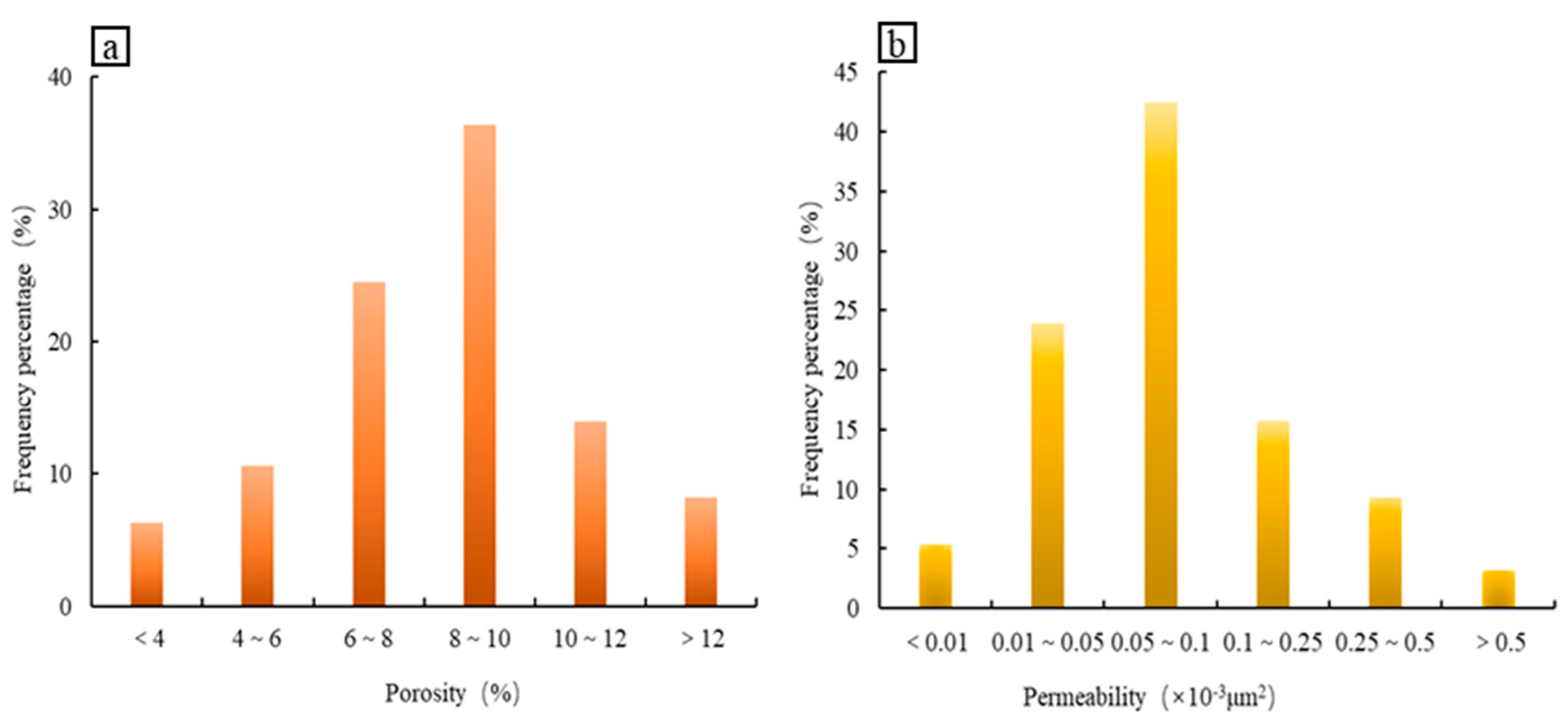
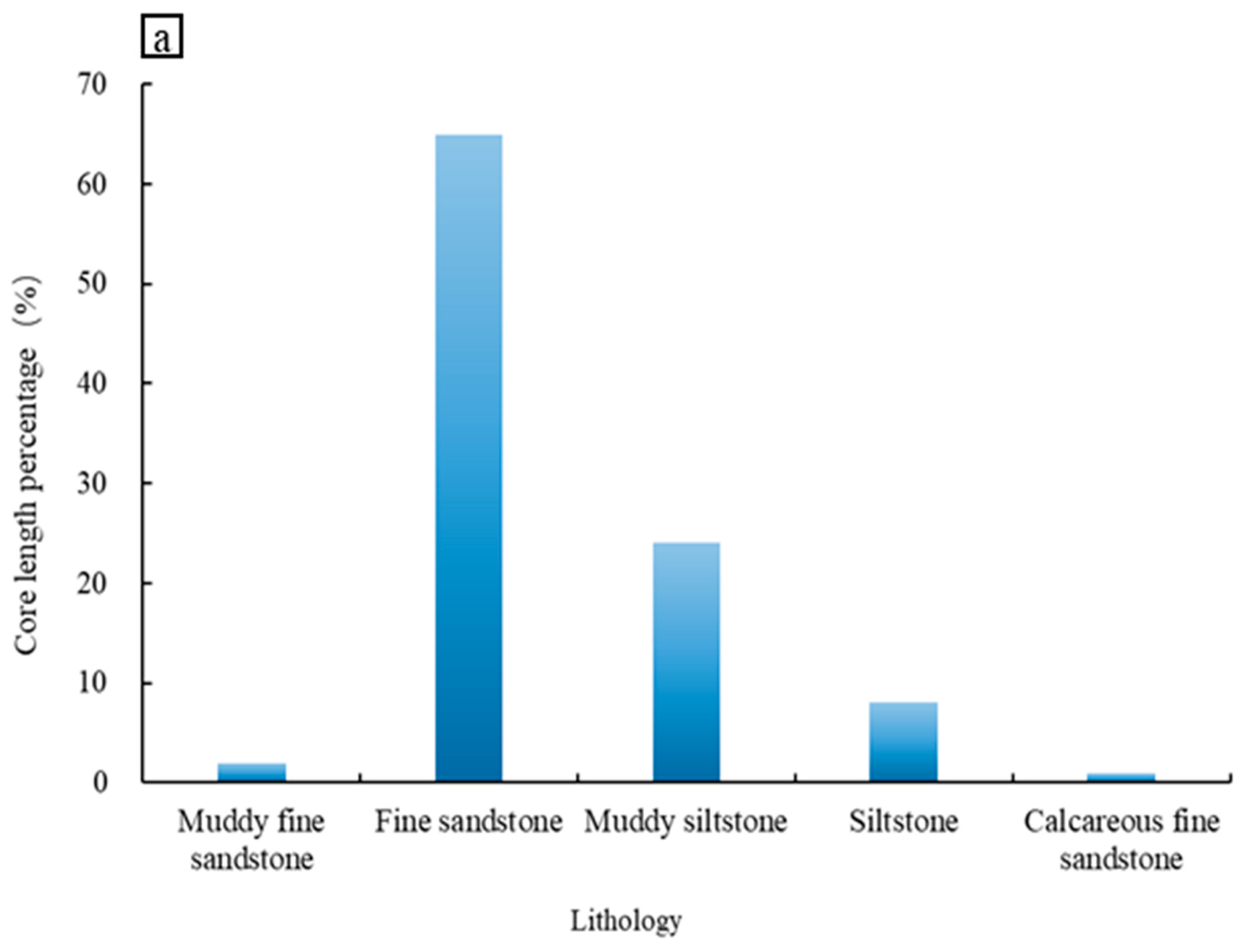

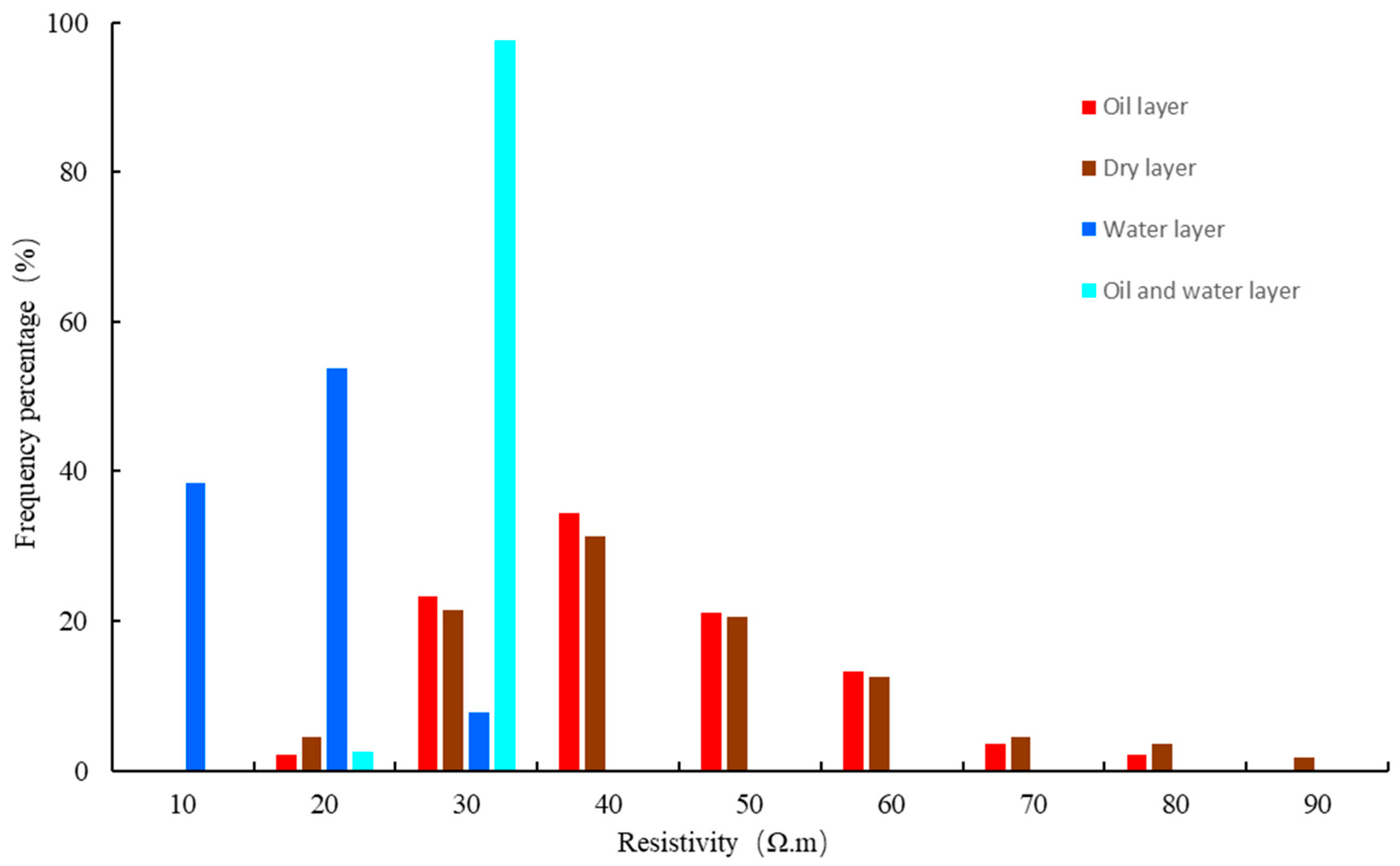
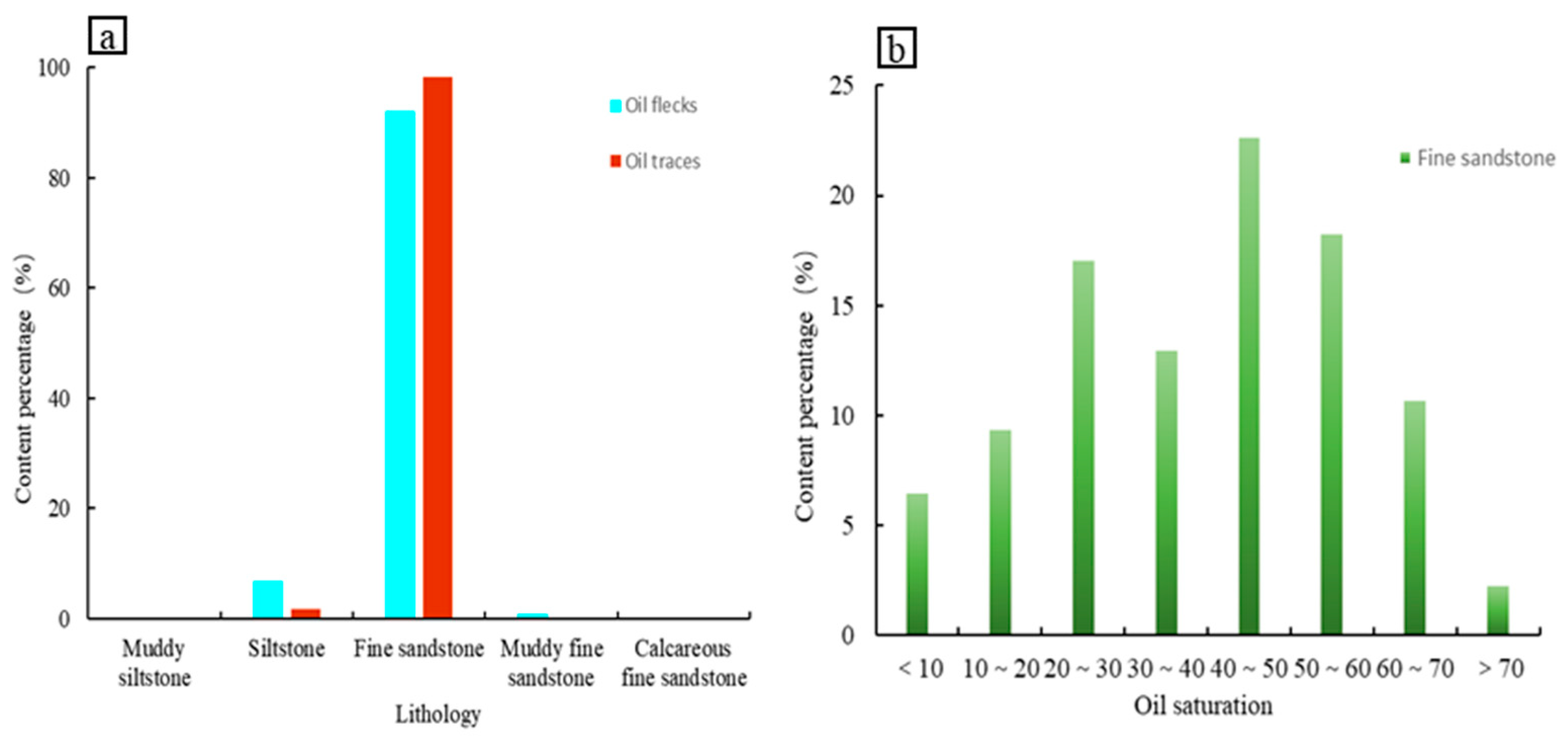

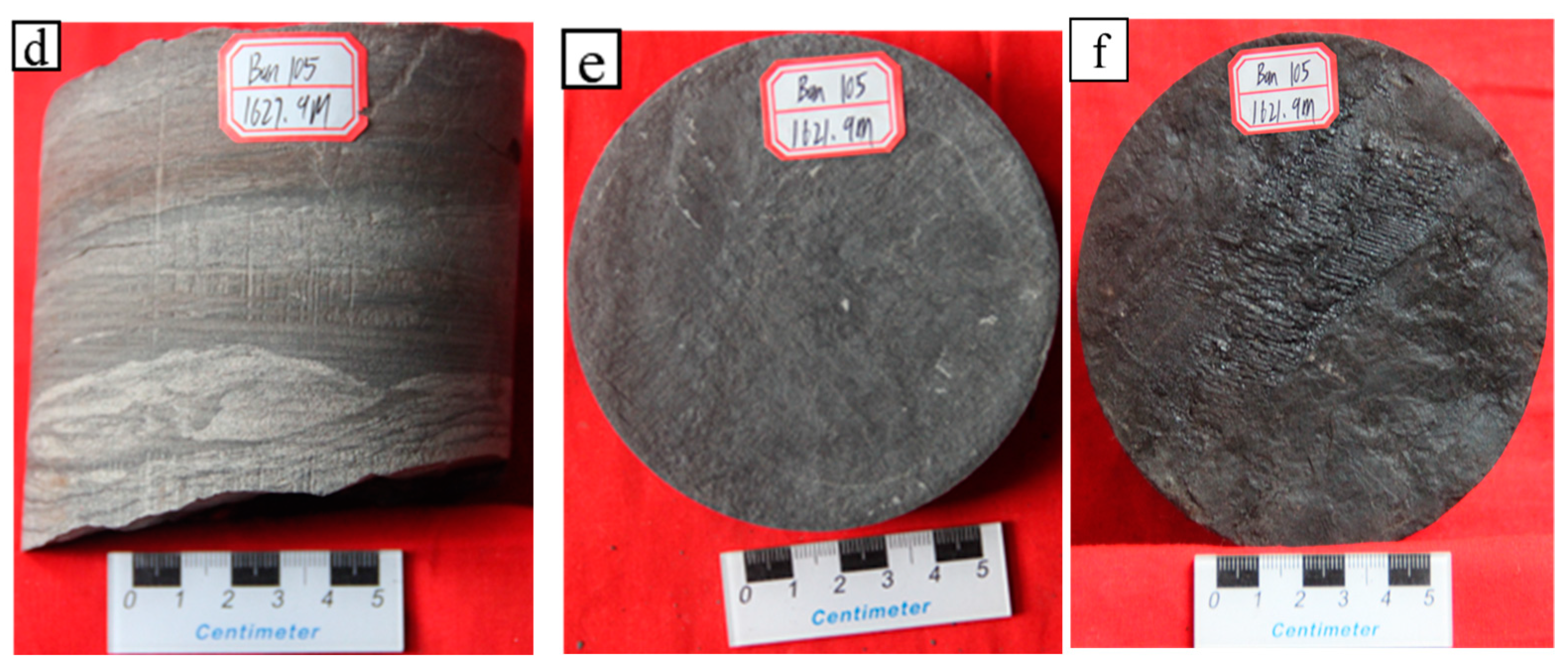


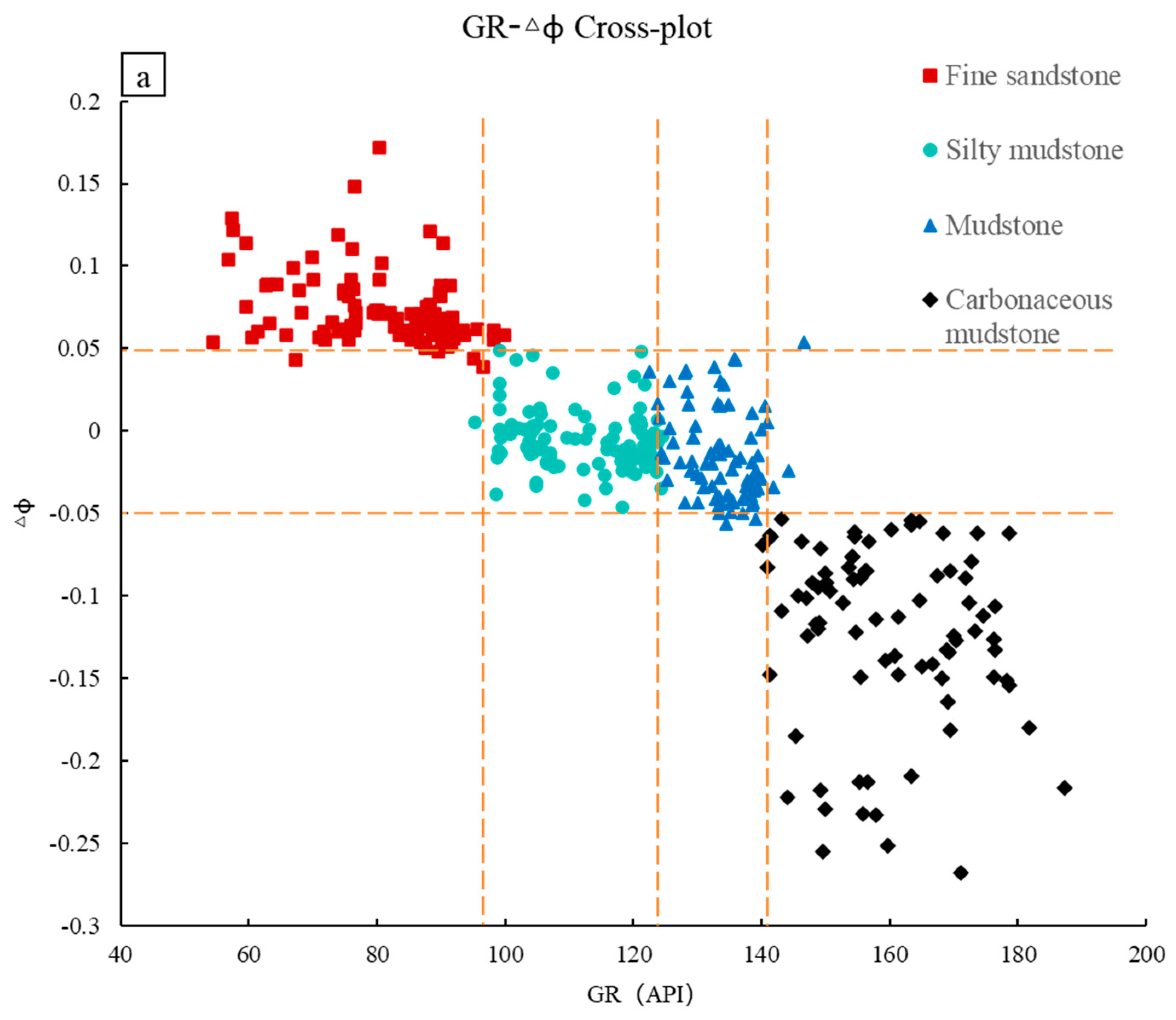
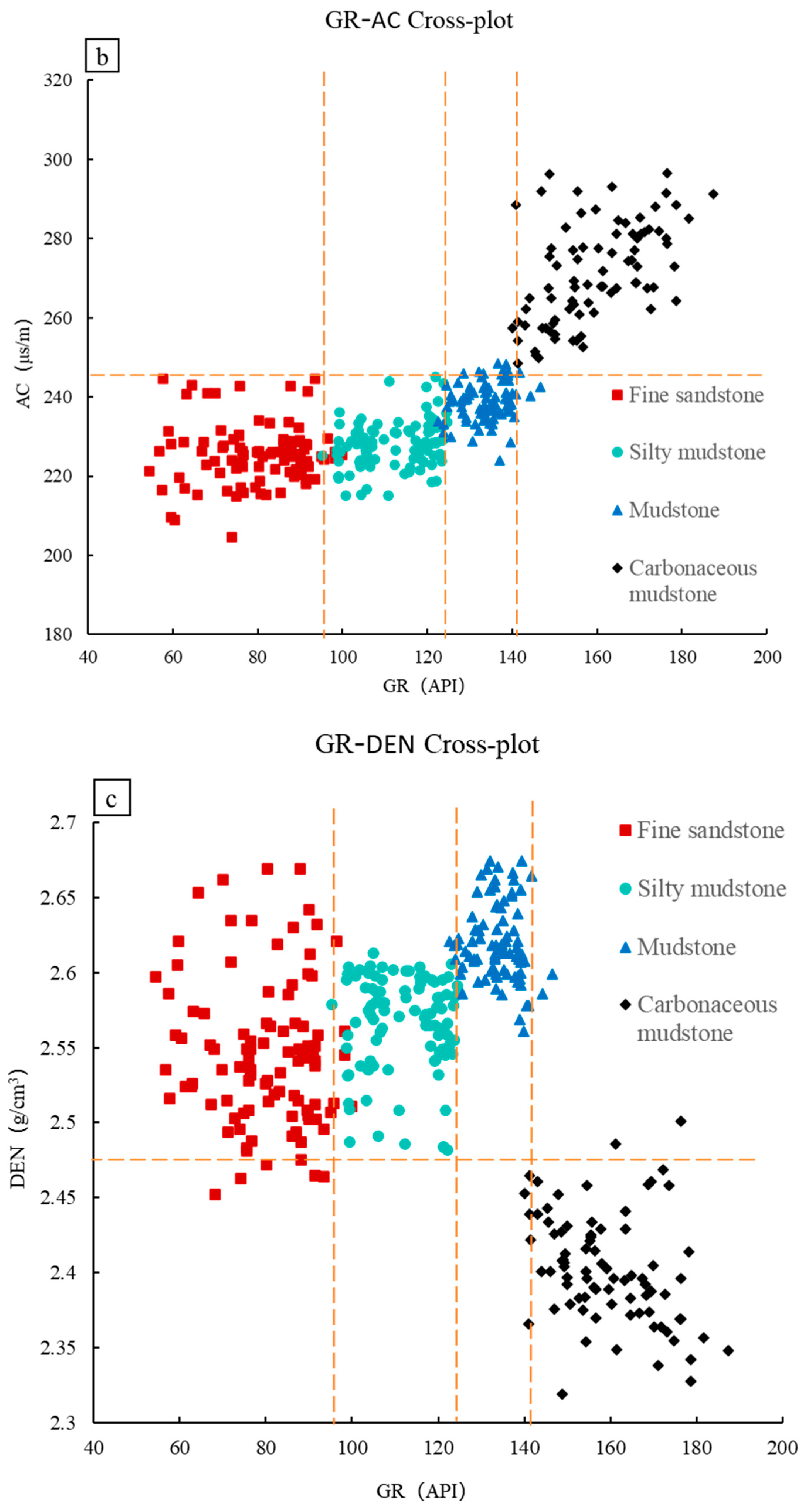
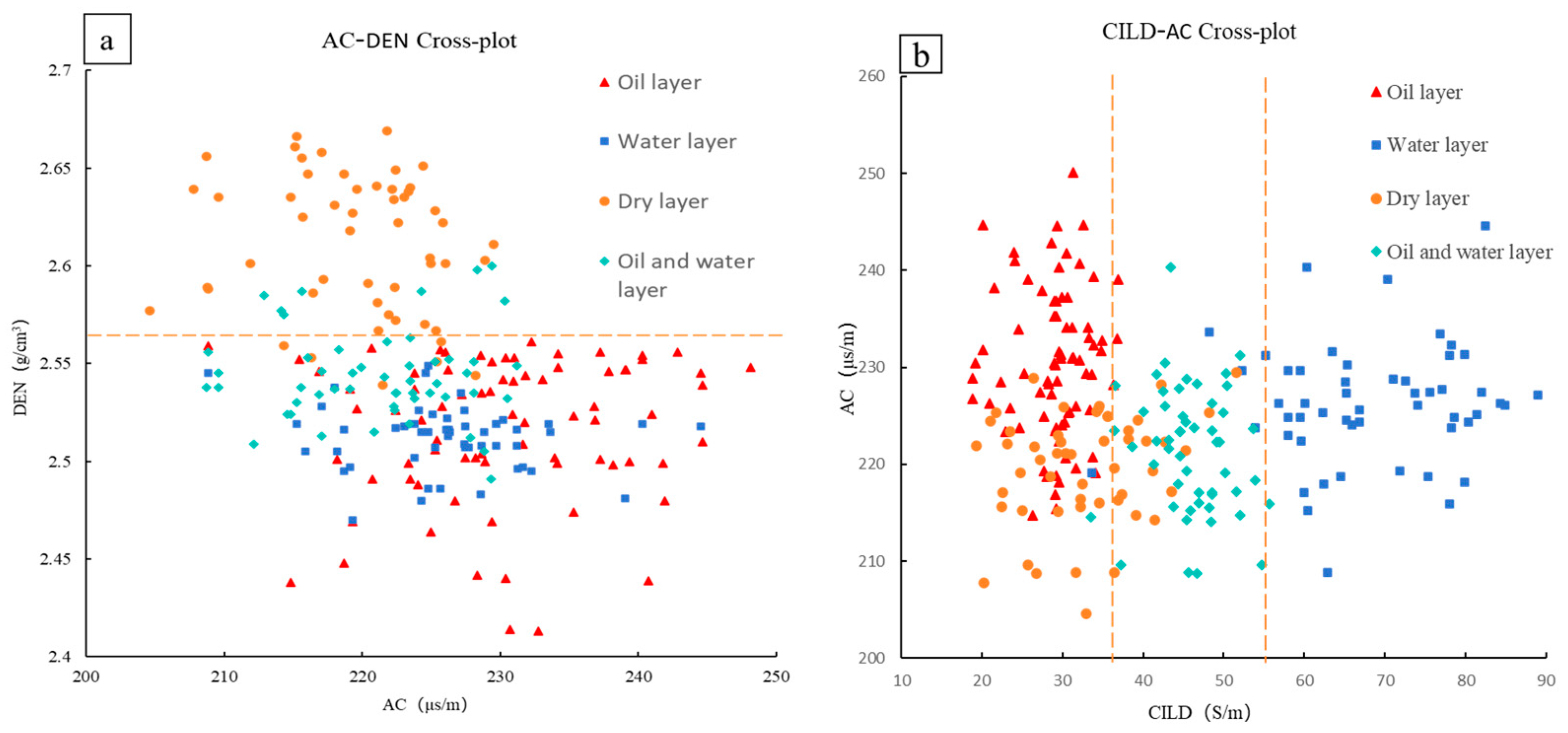
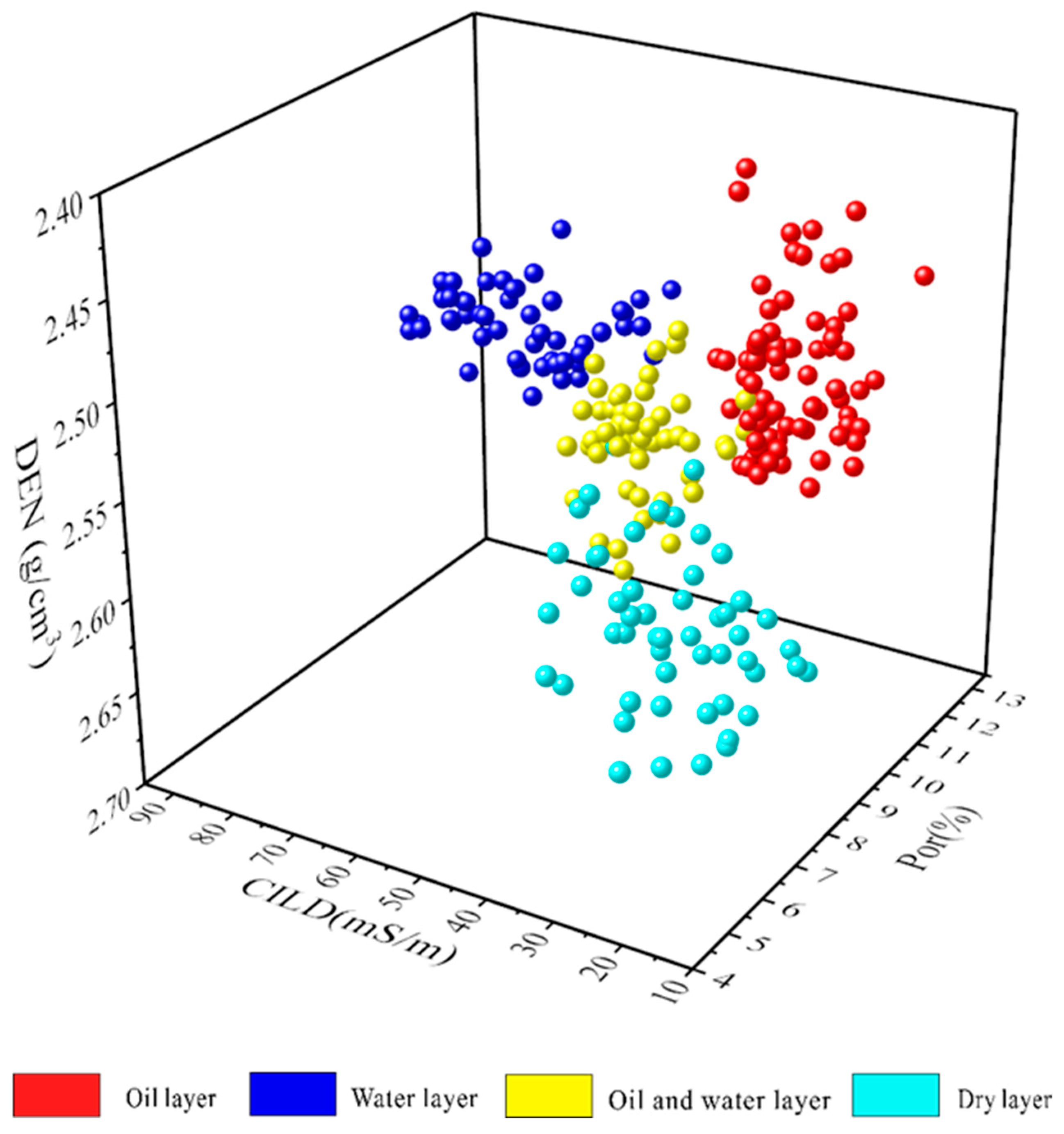
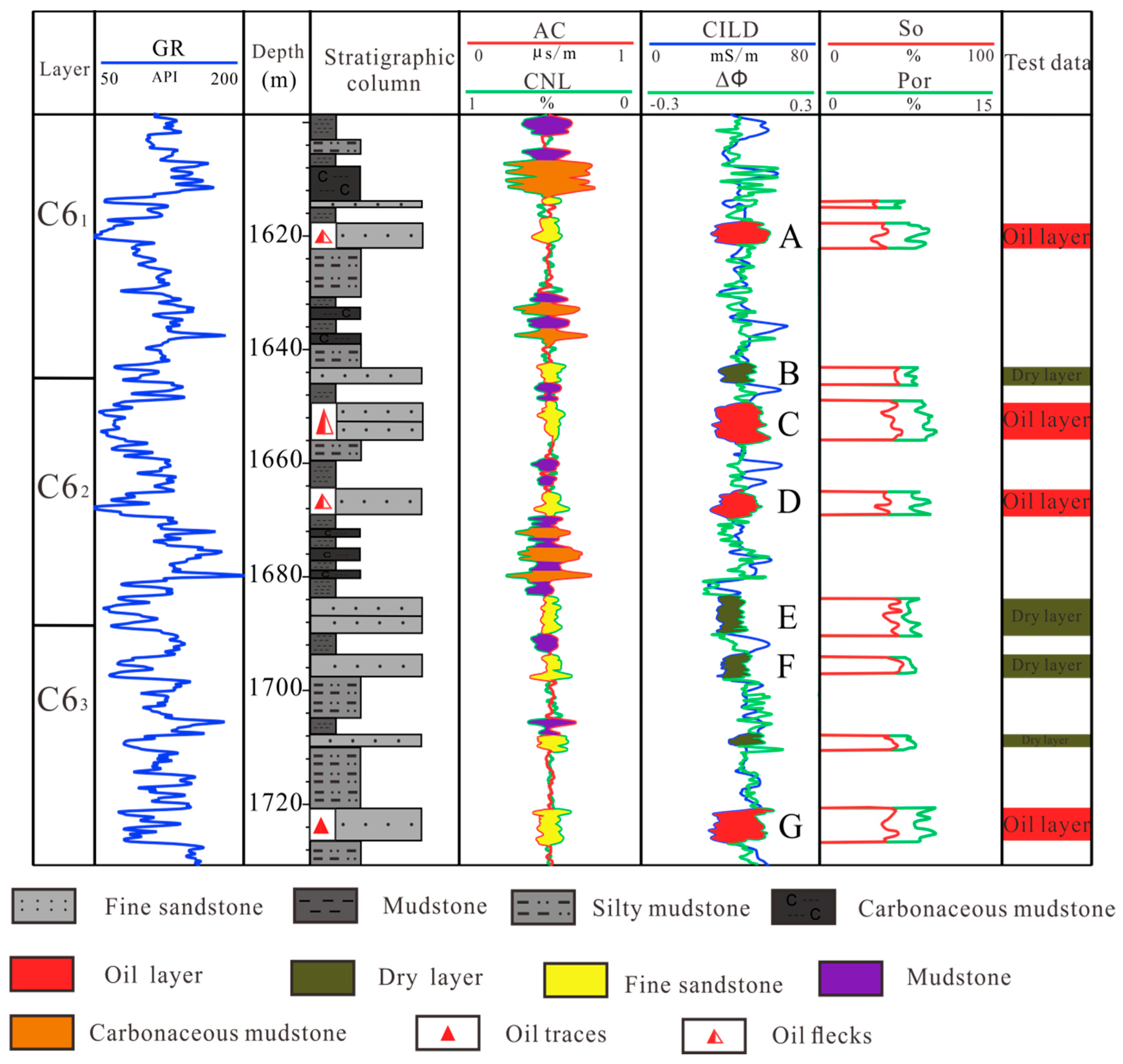

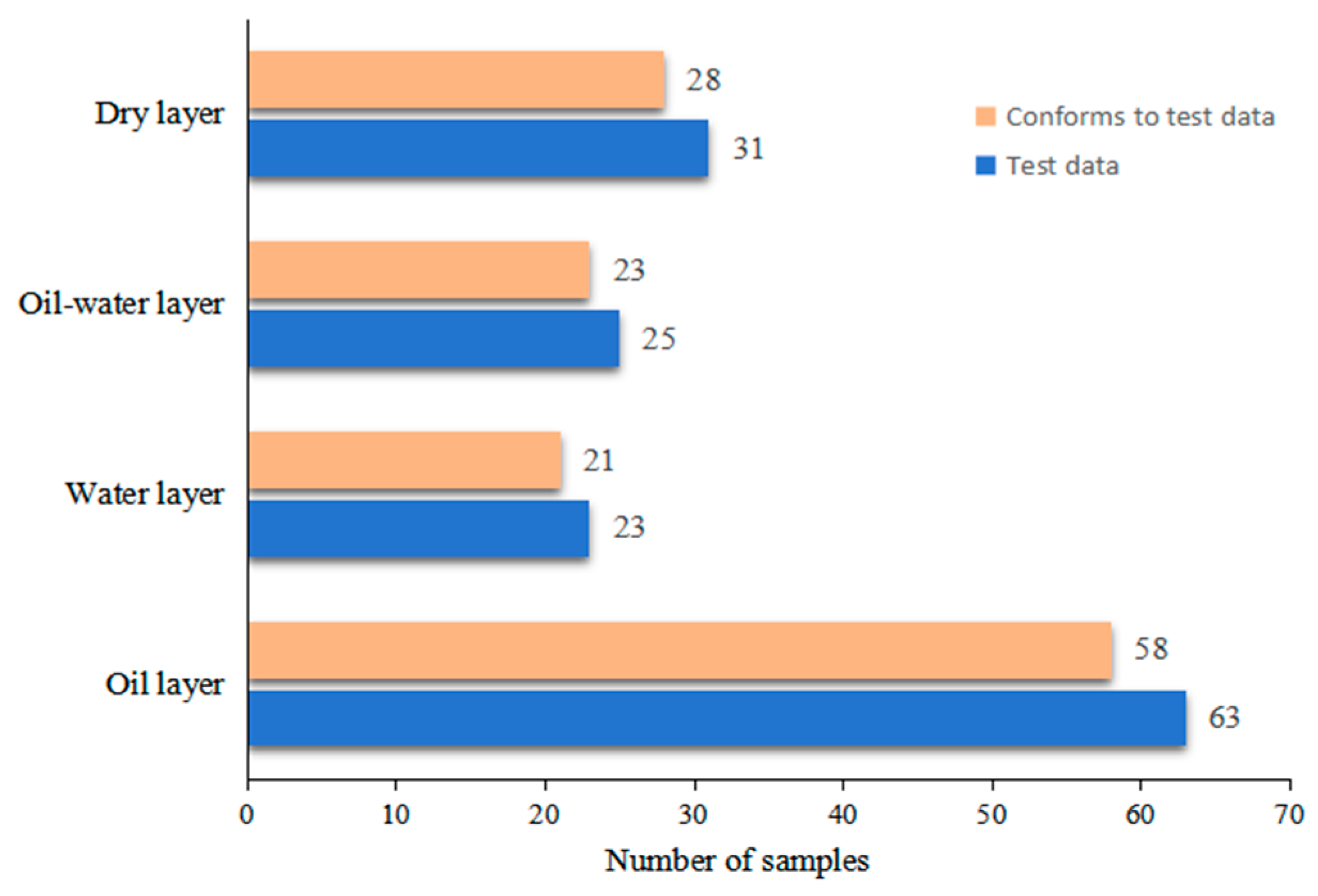
| Lithology | GR (API) | DEN (g/cm3) | AC (μs/m) | Δφ |
|---|---|---|---|---|
| Fine sandstone | 50~96 | 2.46~2.67 | 208~245 | 0.05~0.2 |
| Silty mudstone | 96~123 | 2.48~2.62 | 213~245 | −0.05~0.05 |
| Mudstone | 123~141 | 2.56~2.68 | 223~246 | −0.05~0.05 |
| Carbonaceous mudstone | 141~200 | 2.31~2.46 | 246~300 | −0.05~−0.3 |
| Well Number | Induction Conductivity (mS/m) | Porosity (%) | Identify Test Results | Test Results |
|---|---|---|---|---|
| Y199 | 20.269 | 9.83 | Oil layer | Oil layer |
| Y424 | 24.972 | 10.36 | Oil layer | Oil layer |
| Y87 | 28.144 | 9.71 | Oil layer | Oil–water layer |
| Y76 | 26.838 | 11.28 | Oil layer | Oil layer |
| Y74 | 27.877 | 11.05 | Oil layer | Oil layer |
| Y72 | 19.223 | 10.58 | Oil layer | Oil layer |
| X329 | 28.122 | 9.60 | Oil layer | Oil–water layer |
| X323 | 29.261 | 9.73 | Oil layer | Oil layer |
| X321 | 28.994 | 12.38 | Oil layer | Oil layer |
| X320 | 29.011 | 11.16 | Oil layer | Oil layer |
| X305 | 23.266 | 9.78 | Oil layer | Oil layer |
| L99 | 25.597 | 10.29 | Oil layer | Oil layer |
| L416 | 27.334 | 12.58 | Oil layer | Oil layer |
| Y70 | 49.12 | 9.7 | Oil–water layer | Water layer |
| Y48 | 42.761 | 9.43 | Oil–water layer | Oil–water layer |
| X294 | 33.584 | 10.16 | Oil–water layer | Oil layer |
| X292 | 38.551 | 9.49 | Oil–water layer | Oil–water layer |
| X291 | 54.705 | 9.92 | Oil–water layer | Oil–water layer |
| L389 | 43.248 | 9.55 | Oil–water layer | Oil–water layer |
| L361 | 41.287 | 9.46 | Oil–water layer | Oil–water layer |
| L356 | 45.397 | 9.39 | Oil–water layer | Oil–water layer |
| L282 | 35.484 | 9.07 | Oil–water layer | Oil–water layer |
| L180 | 50.171 | 8.12 | Oil–water layer | Oil–water layer |
| Z30 | 40.031 | 9.44 | Oil–water layer | Oil–water layer |
| Z105 | 44.306 | 8.84 | Oil–water layer | Oil–water layer |
| Y46 | 29.36 | 8.64 | Dry layer | Dry layer |
| Y33 | 27.257 | 6.47 | Dry layer | Dry layer |
| X288 | 41.147 | 7.17 | Dry layer | Dry layer |
| X287 | 40.259 | 8.97 | Dry layer | Oil–water layer |
| L16 | 37.218 | 7.74 | Dry layer | Dry layer |
| L151 | 34.594 | 6.84 | Dry layer | Dry layer |
| Z496 | 42.264 | 7.29 | Dry layer | Dry layer |
| Z130 | 70.979 | 9.89 | Water layer | Water layer |
| Z143 | 53.864 | 10.80 | Water layer | Water layer |
| Z30 | 50.33 | 9.30 | Water layer | Oil–water layer |
| ... | ... | ... | ... | ... |
| Z287 | 65.38 | 10.44 | Water layer | Water layer |
Disclaimer/Publisher’s Note: The statements, opinions and data contained in all publications are solely those of the individual author(s) and contributor(s) and not of MDPI and/or the editor(s). MDPI and/or the editor(s) disclaim responsibility for any injury to people or property resulting from any ideas, methods, instructions or products referred to in the content. |
© 2024 by the authors. Licensee MDPI, Basel, Switzerland. This article is an open access article distributed under the terms and conditions of the Creative Commons Attribution (CC BY) license (https://creativecommons.org/licenses/by/4.0/).
Share and Cite
Ge, Y.; Zhao, K.; Niu, H.; Song, X.; Qiao, L.; Cheng, X.; Feng, C. Logging Identification Methods for Oil-Bearing Formations in the Chang 6 Tight Sandstone Reservoir in the Qingcheng Area, Ordos Basin. Energies 2024, 17, 3966. https://doi.org/10.3390/en17163966
Ge Y, Zhao K, Niu H, Song X, Qiao L, Cheng X, Feng C. Logging Identification Methods for Oil-Bearing Formations in the Chang 6 Tight Sandstone Reservoir in the Qingcheng Area, Ordos Basin. Energies. 2024; 17(16):3966. https://doi.org/10.3390/en17163966
Chicago/Turabian StyleGe, Yanlong, Kai Zhao, Hao Niu, Xinglei Song, Lianlian Qiao, Xiaojuan Cheng, and Congjun Feng. 2024. "Logging Identification Methods for Oil-Bearing Formations in the Chang 6 Tight Sandstone Reservoir in the Qingcheng Area, Ordos Basin" Energies 17, no. 16: 3966. https://doi.org/10.3390/en17163966
APA StyleGe, Y., Zhao, K., Niu, H., Song, X., Qiao, L., Cheng, X., & Feng, C. (2024). Logging Identification Methods for Oil-Bearing Formations in the Chang 6 Tight Sandstone Reservoir in the Qingcheng Area, Ordos Basin. Energies, 17(16), 3966. https://doi.org/10.3390/en17163966





